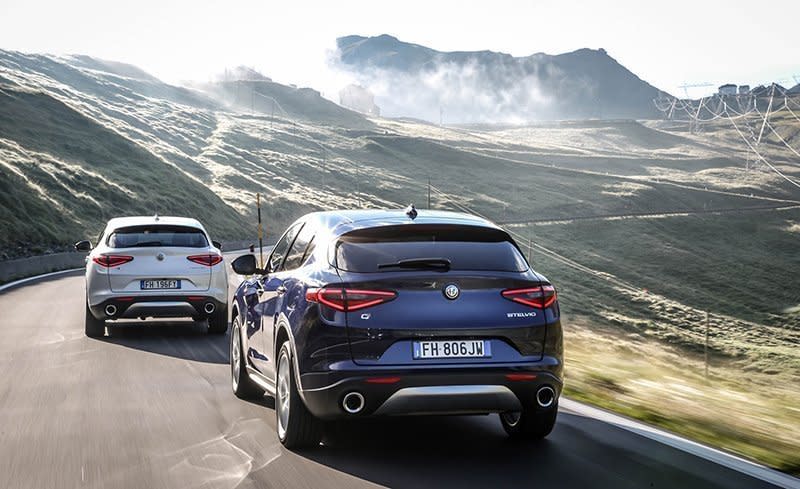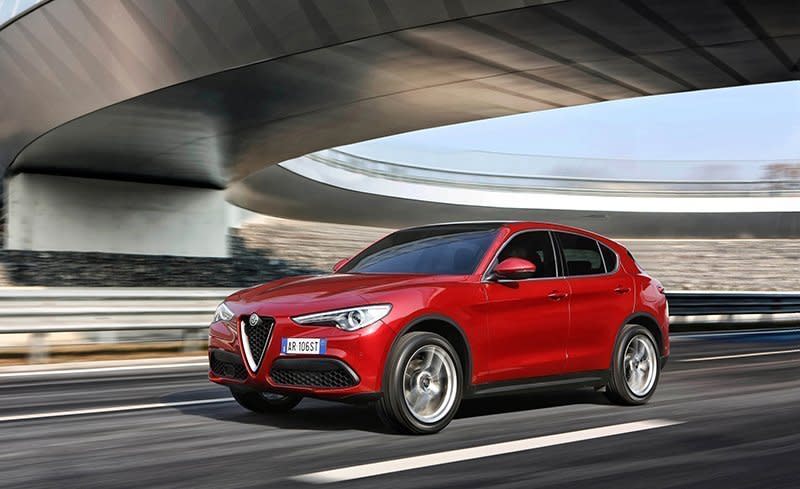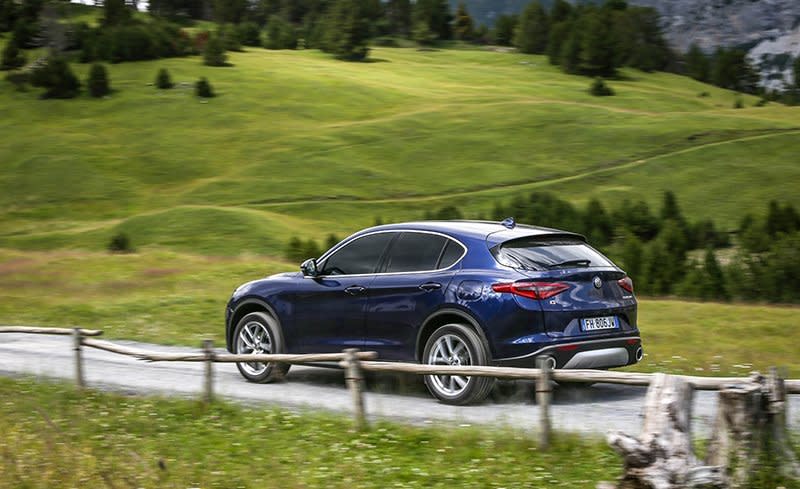2018 Alfa Romeo Stelvio 2.0T and 2.2D Euro-Spec

The more mountainous parts of Italy have previously offered inspiration to those hard-working marketeers responsible for naming new models, but it’s been a while since the muse struck. The Ford Cortina and the Triumph Dolomite, however, have been joined by a new Italian in the shape of the Alfa Romeo Stelvio, an SUV that’s named after Italy’s highest and most famous Alpine pass. We finally got to find out how appropriate the association is.
This should have happened sooner; Alfa wanted to hold the first press launch of the Stelvio on a route including the 9045-foot high Passo dello Stelvio earlier this year, but unseasonably late snow nixed the plan. (In the meantime, we drove the U.S.-spec Stelvios in Tennessee.) Now, this later drive is a chance get acquainted with the more obscure members of the model range behind the wheel of both the lower-powered version of the 2.0-liter gasoline engine and the 2.1-liter diesel, neither of which are offered in the United States.

Environmental Beauty—and Mountains, Too
The Stelvio Pass’s position at the edge of Italy, nestled up against both Austria and Switzerland, means that getting there is always the biggest component of any road trip involving the location. We picked up the cars in Milan, meaning a three-hour trip along both the autostrada freeway and the smaller roads that ultimately carry us to Bormio, a small mountain town that guards the southern end of the pass.
It’s an excellent chance to experience the rear-driven 178-hp diesel inline-four that powers the entry-level model in Europe. (At 2143 cubic centimeters, this engine displaces 2.1 liters, but Alfa markets it as a 2.2-liter.) This uses the same aluminium block-and-head, direct-injected engine that powers most Euro-market versions of the Giulia sedan, although the Stelvio doesn’t offer the sedan’s manual gearbox, instead coming with an eight-speed automatic as standard equipment. As you’d expect, this engine is a slugger rather than a sprinter, with the most telling statistic being the 332 lb-ft peak torque arriving at just 1750 rpm. The diesel Stelvio cruises with a relaxed composure, the quick-shifting auto ‘box keeping the engine in its broad midrange. High-speed refinement is impressive but for some wind whistle from the tops of the doors. And even while sharing switchgear and much of its trim with the Giulia, the Stelvio’s cabin feels both more spacious and classier.
The Stelvio Pass proves to be a tougher challenge, although for reasons well outside of Alfa’s control. A myriad of car advertisements filmed here suggest the pass is a deserted driving paradise, but the reality is considerably busier, especially on a hot summer’s day. The road attracts visitors from across Europe and even further afield, with traffic ranging from bicycles to cars and RVs all the way to full-size tour buses, the biggest of which have to take more than one cut at the steering to negotiate the tighter hairpins. Our Stelvio is soon trailing a long line of traffic travelling at scenery-watching pace.

Still Feels Good
But even gentle loadings prove the fundamental excellence of the chassis and vindicate Alfa’s decision to spend so much money on a weight-trimming aluminum structure. It feels taut and agile, responsive when asked to change direction, and puts up keen resistance to body roll. Ride quality is excellent, well damped and on the firm side, and yet it deals with the lumpier asphalt at higher altitudes without breaking a sweat.
Pausing at a turnout to gawk at the sort of scenery that Heidi had from her bedroom window gives the traffic a chance to disperse and gives us a gap to press harder on the plateau above the second flight of hairpins (there are 38 in total on the Italian side.) Pushed harder, the engine loses its composure, with some frankly industrial noises passing through the firewall as the diesel revs nears its 3750-rpm power peak. Acceleration stays respectable even on the pass’s steep gradients, but the 2.1-liter gives off none of the push-harder vibe that has long been a characteristic of even modestly engined Alfas.
In terms of dynamics, the Stelvio handles pretty much like a taller Giulia. Steering is quick and direct, with the front end responding to inputs cleanly and accurately. There’s little genuine feedback beyond the artificially induced weight of the electrically assisted power steering. Alfa is justifiably proud of the way the Stelvio resists understeer in slower turns, but much of this is due to the aggressive manner in which the stability-control system winds back the engine when it detects the onset of slip. With only rear-wheel drive, the base Stelvio needs to have its front wheels pointing almost straight before there’s enough traction available to let the system feed the power back in.

As in every Giulia barring the full-fat Quadrifoglio, there’s no way of disabling the stability sentinel or even to switch to a more permissive setting; even in its most aggressive Dynamic mode the DNA system doesn’t change the intervention threshold. The result is a fine rear-drive chassis that feels inert under the sort of hard use that should really wake it up; Alfa’s engineering boss Roberto Fedeli later confirms that the company wants to make defeatable stability control standard across the range.
More Cooking with Gas
Driving the diesel demonstrates that, apart from better fuel economy, U.S. buyers aren’t missing out on much through its omission. A switch to the basic gasoline version shows it to be a far more Alfa-appropriate powerplant. This is the lower-powered version of the turbocharged 2.0-liter inline-four found in the U.S. market’s entry-level Stelvio. Whereas the American model’s engine is rated at 280 horsepower (and is also available in Europe), this unit makes a more modest 198 ponies and 243 lb-ft of torque, the latter fully present at 1750 rpm. Unlike the base diesel, it gets all-wheel drive as standard.
The gas engine doesn’t thrill, but it’s far more enthusiastic than the languid diesel. There’s none of the zinging soundtrack that Alfa Romeo used to be able to extract from even its most modest four-cylinder engines, but there’s none of the diesel’s coarseness, either. Although tuned for torque, the gas engine is happy to occasionally kiss its 6000-rpm limiter. Alfa’s claim of 7.2 seconds for the zero-to-62-mph sprint with this engine trails its stated time for the 280-horse version by 1.5 seconds, but it still feels respectably brisk, and some intelligent torque-shuffling by the rear-biased all-wheel-drive system means far less stability-control intervention in slower corners.

Indeed, the gasoline Stelvio proves itself more than fast enough on the run back down from the summit to pretty much set its brakes on fire (the all-hairpin diet helped, too). Alfa has fitted the car with an electrohydraulically assisted braking system which is claimed to be able to adapt to different conditions, but it also effectively masks the softening sensation through the pedal that normally indicates that pads and rotors are overheating. So it was something of a surprise to see black smoke rising from the front wheels when we eventually stopped. Perhaps this electrically assisted system should be taught to deliver some kind of warning of rising temperatures, something akin to the mushy pedal that occurs with conventional brakes.
In all other respects, the Stelvio copes admirably well with its eponymous pass, and although we won’t be getting such basic versions in the States, they provide welcome confirmation of the fundamental strengths inherent to the whole platform. Alfa admits that the Stelvio is the make-or-break model that will decide the company’s entire future. The car is good enough to succeed, so the question is whether the brand—and its dealer networks—can carry it off.
Specifications >
VEHICLE TYPE: front-engine, rear- or all-wheel-drive, 5-passenger, 4-door hatchback
BASE PRICES (Italy): 2.2D, $46,000;
2.0T, $49,000
ENGINE TYPES: turbocharged and intercooled DOHC 16-valve 2.1-liter diesel inline-4, 178 hp, 332 lb-ft; turbocharged and intercooled SOHC 16-valve 2.0-liter inline-4, 198 hp, 243 lb-ft
TRANSMISSION: 8-speed automatic with manual shifting mode
DIMENSIONS:
Wheelbase: 110.9 in
Length: 184.6 in
Width: 74.9 in Height: 66.0 in
Passenger volume: 89 cu ft
Cargo volume: 19 cu ft
Curb weight (C/D est): 4050–4100 lb
PERFORMANCE (C/D EST):
Zero to 62 mph: 7.2–7.6 sec
Zero to 100 mph: 17.0–18.5 sec
Standing ¼-mile: 15.8–17.0 sec
Top speed: 120–135 mph
FUEL ECONOMY (C/D EST):
EPA combined/city/highway: 24–28/22–24/28–33 mpg

 Yahoo Autos
Yahoo Autos 